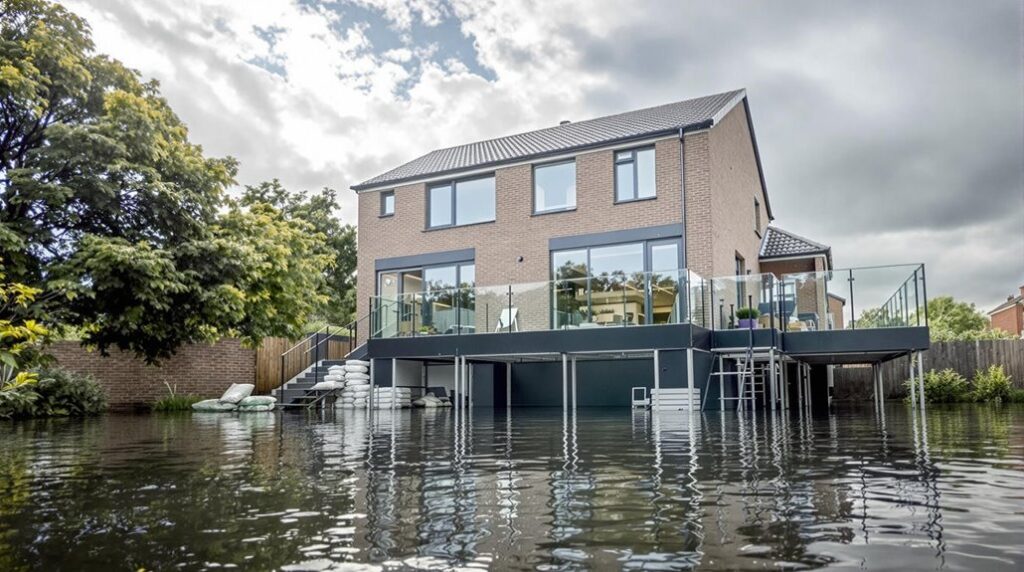I’ve seen firsthand how devastating flood damage can be to UK homeowners, and with climate change intensifying rainfall patterns, your property’s vulnerability isn’t decreasing. Whether you’re in a known flood zone or think you’re safely positioned, the statistics tell a sobering story—1 in 6 UK properties faces genuine flood risk. The good news? There are proven, practical solutions that can dramatically reduce your home’s susceptibility to water damage, and some might surprise you with their simplicity.
Key Takeaways
- Check your property’s flood risk using the Environment Agency’s Flood Maps for Planning tool and consider specialist consultation for high-risk zones.
- Install removable flood barriers for doors and windows, plus automatic air brick covers with BSI kite-marks for quick deployment.
- Replace ground-floor carpets with ceramic tiles and elevate electrical systems above potential flood levels for long-term resilience.
- Create a written flood plan with clear triggers and pre-position sandbags at key entry points for emergency response.
- Use water-resistant building materials like lime plaster and consider permanent floodgates with louvered screens for automatic protection.
Understanding UK Flood Risk Statistics and Vulnerabilities
When evaluating flood-proof housing options, understanding the UK’s current flood risk landscape is essential. I’ll share the stark reality: 6.3 million properties in England currently face flooding risks from rivers, seas, or surface water. That’s 1 in 6 homes—your property might already be vulnerable.
Climate change will dramatically worsen these statistics. By mid-century, flood risk could affect 8 million properties—one in four homes. East Anglia, the Thames Estuary, and Southwest England face particularly severe threats due to rising sea levels and increased winter rainfall. UK sea levels are projected to rise by 11 to 16 cm by 2030 based on emission scenarios.
The Environment Agency’s National Flood Risk Assessment now provides flood depth data, giving you precise risk understanding. Whether you’re facing river flooding, coastal surges, or surface water issues, knowing your specific vulnerability helps you make informed decisions about flood-proofing investments that protect your home and family.
Government Investment in National Flood Defence Programs
The UK government’s unprecedented £7.9 billion flood defence commitment over the next decade represents the largest investment in the nation’s history—and it’s directly relevant to your flood-proofing decisions.
I’ll explain how this funding affects your property protection strategy. The government’s allocating £2.65 billion specifically for 2025-2027, targeting over 1,000 flood schemes nationwide. This includes both traditional barriers and nature-based solutions like wetland restoration, which comprise 30% of projects.
You’ll benefit from enhanced protection for 500,000+ homes and 50,000 businesses by 2030. The investment prioritizes property-level resilience standards and deployable defences for rapid response. Regional focus areas include Yorkshire and Somerset, where recurrent flooding demands immediate attention.
This strategic investment delivers exceptional value, with every £1 spent on flood defences expected to prevent £8 in damage. This all-encompassing approach reduces your individual flood-proofing burden while supporting community-wide resilience strategies.
Evaluating Your Property’s Flood Risk Profile

How do you determine whether your property faces genuine flood risk or just theoretical concern? I’ll walk you through the essential assessment process that transforms uncertainty into actionable intelligence.
Start by checking your property’s Environment Agency Flood Zone designation using their Flood Maps for Planning tool. You’ll need to compare your floor levels against predicted flood depths, factoring in climate change allowances. Don’t overlook surface water accumulation—it’s often overlooked but frequently devastating.
For properties in Zones 2 or 3, I recommend commissioning specialist flood risk consultants who’ll conduct hydraulic modeling and calculate flood velocity plus duration. They’ll assess your building’s vulnerability based on construction materials, foundation type, and occupant safety factors. These chartered engineers possess extensive knowledge of current legislation and access to the latest flood modelling data to ensure accurate assessments.
This professional evaluation becomes your foundation for informed decision-making.
Essential Immediate Flood Protection Strategies
Armed with your flood risk assessment, you’ll need rapid-deployment defenses that can be activated within hours of a flood warning. I’ll focus on the most critical immediate actions that protect your home’s vulnerable entry points.
Start with door and window barriers—removable flood barriers that you can deploy quickly when alerts activate. Don’t use them for depths exceeding one meter, as they’ll compromise your structure. Supplement with sandbags at entry points for temporary reinforcement.
Install automatic air brick covers with BSI kite-marks for reliability. Position them for quick deployment and test bi-annually to guarantee proper fit.
Pre-stack sandbags at key locations and anchor temporary barriers to fixed structures. Most importantly, create a written flood plan with clear triggers for deploying these measures.
Turn off the water line if a flood is imminent to prevent contamination and additional water damage to your property’s internal systems.
Long-Term Property Resilience and Adaptation Solutions

While immediate flood defenses buy you precious hours, permanent property modifications deliver lasting protection that transforms your home’s vulnerability into resilience. I recommend installing permanent floodgates with louvered screens that automatically deploy during flood events while maintaining your home’s aesthetics.
You’ll want to replace ground-floor carpets with ceramic tiles and apply lime plaster to walls for superior water resistance. Elevate your electrical systems above potential flood levels and relocate boilers to upper floors using marine-grade components. Additionally, using water-resistant building materials can significantly enhance the durability of your home against flood damage.
Consider constructing on raised piles with sacrificial lower levels designed for easy cleanup. Incorporate rain gardens to divert surface water naturally. Installing permeable paving can significantly reduce surface water runoff while maintaining the functionality of your driveways and walkways. Document these modifications for insurers—it’ll help negotiate lower premiums. Professional Flood Risk Assessments guarantee your adaptations match your property’s specific vulnerabilities.
Building Considerations for Flood-Prone Areas
When you’re planning construction in flood-prone areas, regulatory compliance becomes your foundation for creating safe, resilient buildings that won’t exacerbate existing flood risks. You’ll need to navigate flood risk zones that dictate assessment requirements—Zone 1 presents low risk, while Zones 2, 3a, and 3b require mandatory Flood Risk Assessments for any development.
I recommend prioritizing design adaptations that work with water rather than against it. Raise your floor levels above predicted flood depths, specify flood-resilient materials like waterproof plaster and tiled floors, and guarantee safe egress routes remain accessible during flooding events. You’ll also need to integrate sustainable drainage systems that allow surface water infiltration where feasible. Under the Flood and Water Management Act 2010, local authorities designated as Lead Local Flood Authorities must ensure coordination of flood risk management practices in their areas. These building considerations create homes that protect both your investment and our shared community resilience.
Conclusion
I’ve outlined the critical steps you need to take to flood-proof your UK home effectively. You’ll protect your property by evaluating your risk profile, implementing immediate barriers, and investing in long-term adaptations like elevated systems and water-resistant materials. Don’t wait for the next flood warning—start with an emergency plan today, then gradually upgrade your home’s resilience. Your proactive approach will safeguard your investment and guarantee your family’s safety.
References
- https://www.gov.uk/government/news/hundreds-of-thousands-of-homes-and-businesses-to-benefit-from-largest-flood-defence-investment-programme-in-history
- https://www.netlawman.co.uk/ia/how-flood-proof-your-home
- https://www.floodprotectionsolutions.co.uk/the-uks-housing-problem-flooding/
- https://historicengland.org.uk/advice/your-home/flooding-and-older-homes/being-prepared-for-flooding/
- https://www.theyworkforyou.com/wrans/?id=2025-02-21.32283.h
- https://getrealonclimatechange.org/2024/10/02/which-areas-of-the-uk-could-face-flooding-in-2025-based-on-research/
- https://thefloodhub.co.uk/wp-content/uploads/2018/10/Know-your-flood-risk-FloodGuide_ForHomeowners.pdf
- https://environmentagency.blog.gov.uk/2025/01/28/enhancing-flood-and-coastal-erosion-risk-digital-services-with-the-latest-data-and-mapping/
- https://www.publicfirst.co.uk/wp-content/uploads/2025/03/From-risk-to-resilience-report_PF_180325.pdf
- https://www.unda.co.uk/news/flood-defence-gets-7-9bn-investment-in-uk-infrastructure-push/

